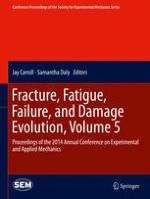Fracture, Fatigue, Failure and Damage Evolution, Volume 5: Proceedings of the 2014 Annual Conference on Experimental and Applied Mechanics, the fifth volume of eight from the Conference, brings together contributions to this important area of research and engineering. The collection presents early findings and case studies on a wide range of areas, including:
Mixed Mode Fracture I: Emphasis on Modeling
Mixed Mode Fracture II: Emphasis on Experimental Measurements
Full-Field Measurements of Fracture
Microscale & Microstructural Effects on Mechanical Behavior I: Nanoscale Effects
Microscale & Microstructural Effects on Mechanical Behavior II: MEMS
Microscale & Microstructural Effects on Mechanical Behavior III: Microstructure
Microscale & Microstructural Effects on Mechanical Behavior IV: Shape Memory Alloys
Fracture & Fatigue of Composites
Fracture & Fatigue for Engineering Applications
Wave-Based Techniques in Fracture & Fatigue I
Wave-Based Techniques in Fracture & Fatigue II: Acoustic Emissions
